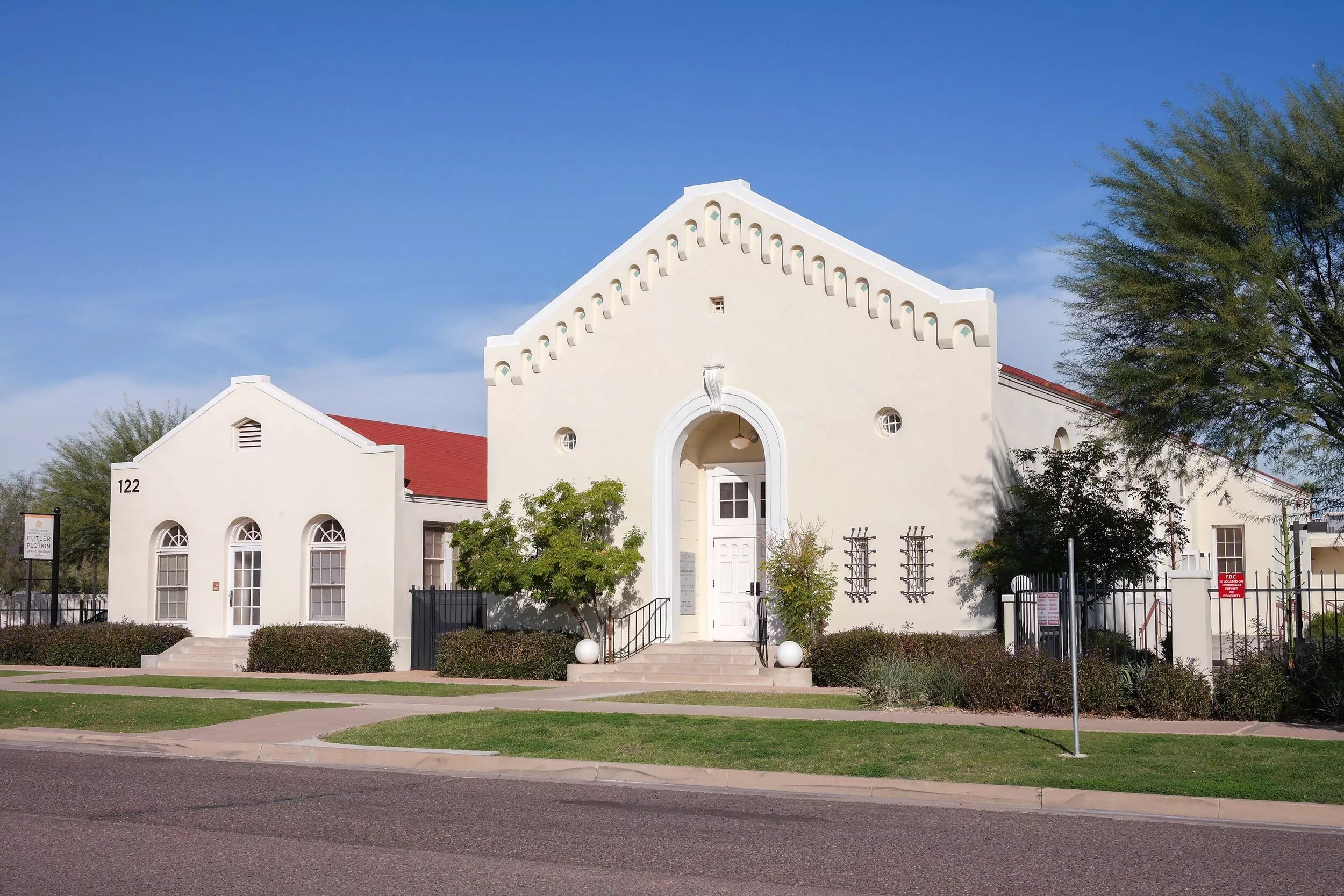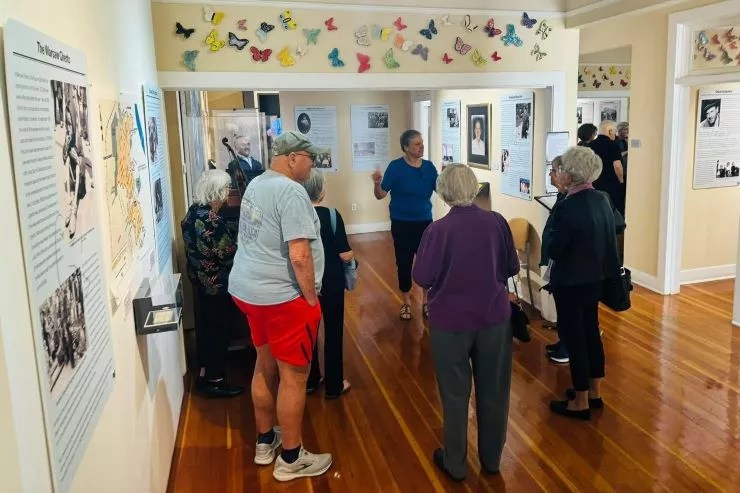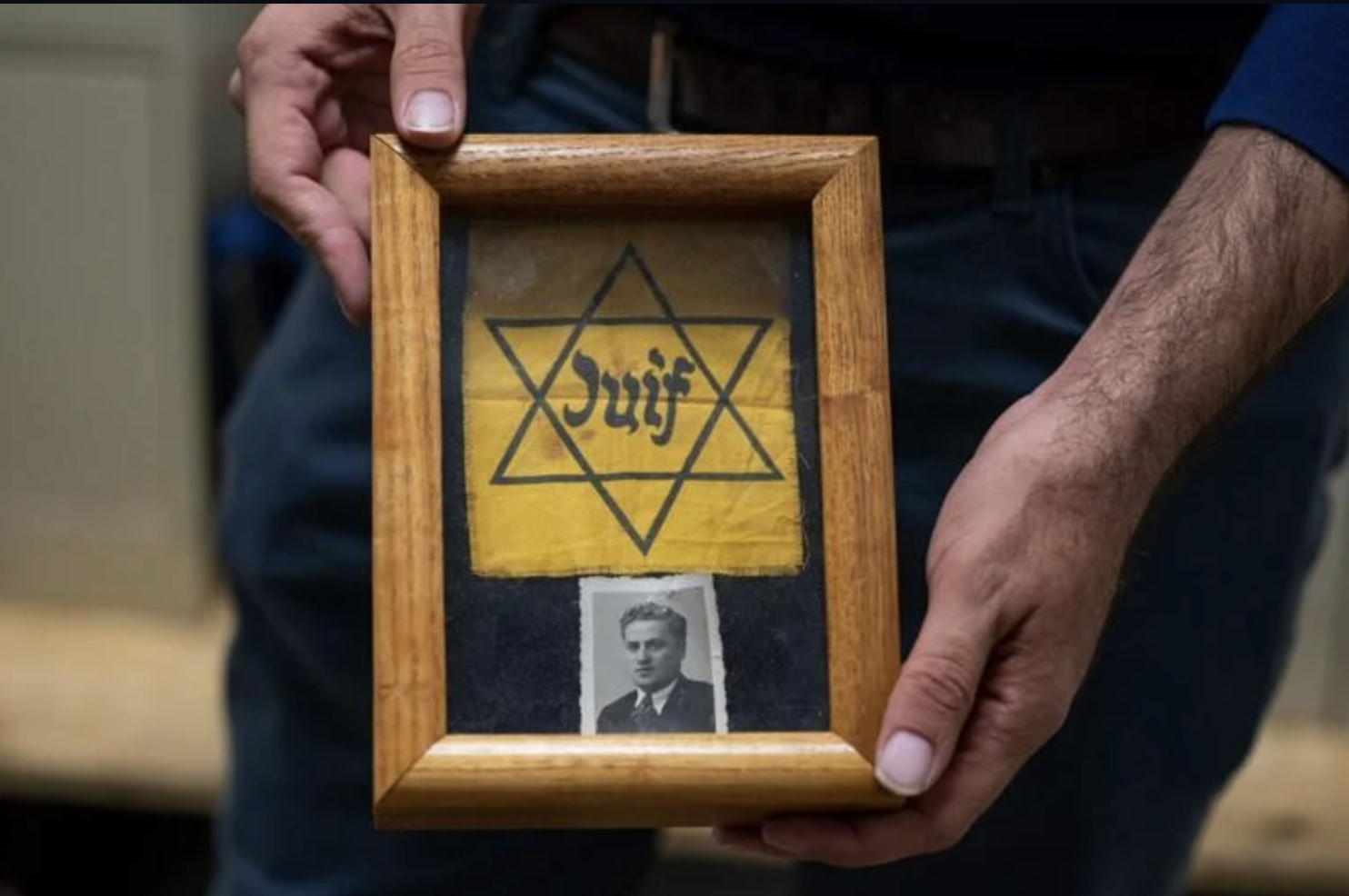
Arizona Jewish Historical Society

Audio By Carbonatix
As the Trump administration emulates authoritarian fascist regimes throughout history: flouting constitutional law, illegally deporting people, targeting marginalized groups as well as anyone who dissents and striving to create an atmosphere of fear-it is important to learn from past atrocities, which still inform our present moment.
The Arizona Jewish Historical Society has been a staunch keeper of vital knowledge and Holocaust history since 2002. Overlooking Hance Park, the Cutler-Plotkin Jewish Heritage Center is housed in a historic building founded in 1920 as Phoenix’s first permanent synagogue.
Today, this space is dedicated to an intimate and immersive exhibition that follows the lived experiences of Holocaust survivors, and includes rare artifacts, such as yellow Star of David patches which Jewish people were forced to wear as identifiers, a concentration camp uniform and spiritual artifacts which were some of the only undestroyed objects from Kristallnacht, the night in 1938 when Jewish homes, shops and synagogues were vandalized and set ablaze in coordinated attacks throughout Germany and Austria.

The Hilton Family Holocaust Education Center is expected to open in Phoenix in 2027.
Rendering courtesy of Arizona Jewish Historical Society
Will you step up to support New Times this year?
At New Times, we’re small and scrappy — and we make the most of every dollar from our supporters. Right now, we’re $15,500 away from reaching our December 31 goal of $30,000. If you’ve ever learned something new, stayed informed, or felt more connected because of New Times, now’s the time to give back.
Jewish people were not the only targets of Nazi violence. Hundreds of Black and mixed-race children were sterilized. Nazis targeted and murdered millions of LGBTQ+ and differently abled people, as well as intellectuals, dissenters, Roma, Poles and other Slavic peoples.
Today, the Trump administration has already begun erasing trans and nonbinary people from public life, openly attacks diversity, is pursuing mass deportations and is disappearing Americans into vast internment complexes.
In Gaza today, the world is witnessing another ongoing human rights atrocity. In the last 15 months, an estimated 46,000 Palestinians have been killed, with 18,000 of those being children. International Human Rights Watch groups, as well as Jewish leaders, including Rabbis for Ceasefire and Jews for Racial and Economic Justice, have been calling for an end to this violence.
In this fearful atmosphere, it’s easy to lose hope. Through the exhibition at the Arizona Jewish Historical Society, brightly colored ceramic butterflies decorate the walls juxtaposed with Holocaust artifacts. Made by middle-schoolers throughout Arizona today as they learned about the experiences of children during the Holocaust, these simple but profound artworks are reminders that healing can happen when we learn from history.
The AZJHS broke ground on its new Hilton Family Holocaust Education Center last month. By continuing to share the personal stories of Jewish people, and honoring the memory of the 6 million Jews who died at the hands of Nazi perpetrators, AZJHS’s mission is to show resilience and courage to future generations.
Phoenix New Times spoke with Rabbi Jeffrey Schesnol, the AZJHS cultural and HEC project director, about the unique history of Jews in the Southwest, the fascinating personal stories behind their physical artifacts, how the Trump administration’s attacks on transgender people mirror Nazi violence and more.

Visitors to the Cutler-Plotkin Jewish Heritage Center learn about history.
Arizona Jewish Historical Society
Phoenix New Times: What is the history of the Arizona Jewish Historical Society and the Jewish community here in Phoenix?
Rabbi Jeffrey Schesnol: The building was built in 1921 by Temple Beth Israel, which was the very first congregation in the city of Phoenix, and the building was the first temple built in the city. The first synagogue built in the state was down in Tucson.
What was Jewish life like at the time?
At the time, there were approximately 125 Jewish people in the city of Phoenix and the surrounding area. Of course, it was nowhere near as large a geographic or population center as it is today. … At the time, there were even a few Jewish cowboys.
Some Jewish people came directly from Europe, across the U.S., but the real majority of the influx occurred in the 1840s, when people seeking their fortune in mining were going to California for the Gold Rush. Copper and silver mining became popular in Arizona. Many Jewish people were merchants, families, who bought products of all types in the east and brought them west. These merchants became the backbone of America’s department store trade. The Solomons, the Goldwaters, the Diamonds – all of these were families who started early department stores. They started as small general stores that had a bit of everything and grew from that.
So these Jewish people needed a place to practice and share community, and that became the synagogue?
Yes, from 1921, the building served a variety of purposes for the Jewish community. Not only was it a house of prayer, it was a social hall, it was a place for community congregation for all kinds of events. The architects were Lescher & Mahoney, who in their day were the most prominent architectural firm in the entire West. The main architectural features of their buildings were arches. They created what has become a timeless design. Today, the building is still used the way it was intended, not just for religious functions, but also a social hall, a meeting place.

Hilton Family Holocaust Education Center in Phoenix will feature two floors of galleries and will encourage visitors to learn about the history of the Holocaust to prevent future genocide.
Rendering courtesy of Arizona Jewish Historical Society
One of the goals of genocide is not only to erase human beings, but to erase cultural memory. So the work you are doing is about preserving Jewish culture. You have artifacts in the exhibition, including a yad (a special pointer used to read Torah) that survived Kristallnacht and a concentration camp uniform. Why is it important to see these objects?
It is the most important work I will do professionally in my life. When a student or visitor sees these up close, the real thing, not a reproduction but the actual artifact, it is profound. In 2018, we did an exhibition called Violins of Hope. A woman, Christina Diamant, who lived in Tempe heard about the exhibit, and she had a violin in a closet that her father had played. Her father, Max Diamant, and his brother Chaim were being deported from the ghetto in which they lived. They were being sent to a concentration camp in southeast Poland. Max, upon boarding the train, happened to have a loaf of bread and a pair of pliers. As the train was coming to a bend in the tracks and slowing down, Max said to Chaim, “let’s jump off the train.” … Max pried open the barbed wire in the top portion of the railcar and jumped. He hit a telephone pole when he jumped and his loaf of bread acted as a shock absorber. Before boarding, Max and Chaim had taken their most prized possession, a violin, and buried it in the forest.
Max managed to make his way back to the town where they were from. A Polish Catholic teenager named Stefania Podgorska, who worked in his parents’ bakery, with all kinds of personal risk to herself and her younger sister, took Max in and hid him in her attic. Max begged her to bring in his other relatives from the ghetto. So there were 13 Jewish people hiding in the attic above where Stefania and her sister Helena lived. When the Soviets finally liberated the town, Max went to the place where he had buried the violin and dug it up. Max and Stefania had fallen in love, they got married and Max testified at the Eichmann trial. Then they moved to the U.S. and lived in Tempe. Christina, his daughter, said, ‘You can show this violin, but I don’t want it restored to make it all pretty. I want it to look just like when my father used to play it.”
On your website, you have a very strong inclusivity statement, making a point to say that anyone of any gender, race or religious background is welcome to come learn this history. In that context, I want to talk about queer and trans people who were targets of Nazi persecution. Jewish-German doctor Magnus Hirschfeld was doing groundbreaking work on trans and gender-diverse people. On May 6, 1933, a Nazi student group marched on Hirschfeld’s Institute for Sexual Science in Berlin, murdered a trans woman and held a public book burning of all Hirschfeld’s research. The moment we are in now with the Trump administration trying to eradicate trans and non-binary people – these are signs of fascism.
Totally. It is inexcusable and unacceptable, and we will resist. We will acknowledge all the people who perished in the Holocaust, the people who were queer, the Romas, the differently abled, the intellectuals, the infirm – who were the very first to go into the gas chambers as their “experimental” group – and all the work that was done by those crazy Nazi “medical” people, like Mengele, who delighted in their torture. It has to be called out for what it is.
It’s so important for me as a nonbinary person who is also Jewish, to learn about tumtumin and androgynos, and recognition of different variations of gender in Torah and Talmud. It is vital and beautiful to have that recognition in one’s own cultural history.
In terms of human rights, those rights have been extended way beyond just a patriarchal system in Judaism. In the new center we are building, we were going to make all the bathrooms nonbinary – individual stalls with doors and a common area sink and mirror. The city of Phoenix was told by the people who dole out federal funds that if the city gave a building permit to do that, their federal funds would be withdrawn. So we were indirectly forced to create binary bathrooms, when that was not our design. It is terrible.
That is so insidious. Especially as a historical and cultural society, that is a violation of being able to practice Judaism. If it says in the Torah that Avram and Sarai were tumtumin, and we have always recognized at least six genders, whether or not that is part of religious practice, it is part of cultural understanding.
You know, that in Judaism, there is also the feminine aspect of God, which is called the Shekinah. God is the concept of total androgyny. God is nonbinary. In the literature, you may see an old man with a white beard, but that is just a reflection of what different societies perceive at any given time. But the reality is God is undefinable – sexually, ethnically, in gender, in any way, cannot even be envisioned. So I think it is a very significant part of Judaism that there literally is a Shekinah.
Denominationally, I am a humanistic Jewish Rabbi. We don’t depend on any authority, whether it be God, government or other, to tell us what to do is right. We know what to do is right, so we don’t have to pray to make that happen – we have to respect each other as human beings.

A yellow star worn during the Holocaust is accompanied by a photo of the man who wore it.
Arizona Jewish Historical Society
Speaking of humanism, I would like to speak about what is happening in Palestine right now. For me, as a Jewish person, reading about Holocaust history, especially the ghettoization of Jews in Nazi Germany – forcing a marginalized population, including children and infants, into an enclosed area and denying them food, medical supplies and removing their humanity – reminded me so much of the treatment of Gazans today. I found this extremely upsetting. As a Jewish person, that is unacceptable to me. Our own history teaches us that this can never happen again, not just to Jews, but to anyone.
That’s true. It’s another whole long conversation. I’m sure you will find your voice to write about it.
Do you have any comment?
Only that every human being must be accorded dignity, no one should be denied dignity. We don’t have a right to deny another human being their dignity.
What are your goals for the future of the AJHS, and continuing to share vital Jewish history and culture with the world?
Hopefully, this important work will not be infringed upon by any governmental agency or any other authority, that this work be the truth, that we speak truth to power and that we can make a difference. That we can get people to say, “I want to practice tikkun olam, I want to heal the world.” Because it is the right thing to do. Not because anyone is looking over my shoulder, cosmically or otherwise. This is the importance of what we call being a mensch – we want all these visitors who come to our new center to walk out and feel they have the opportunity to be a mensch, that they will be upstanders, they won’t stand idly by, they’ll be affected by what they see and hear.